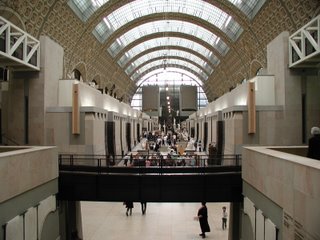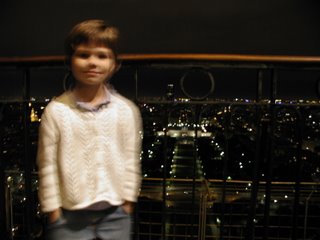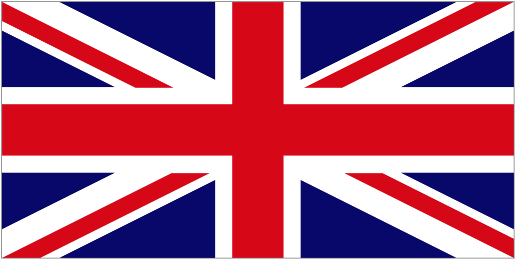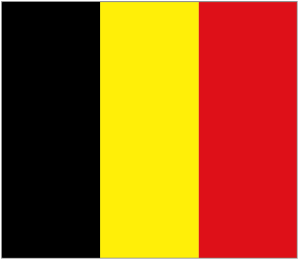We started our first Parisian day with breakfast in the hotel. Coffee, croissants, baguettes, and orange juice, plus hard-boiled eggs if you like.
Then we walked downhill past the Moulin Rouge (which means "red windmill") to the
Paris Metro station at Blanche. (Abbesses was closer, but closed for maintenance.) The system was not hard to learn, especially after getting to know similar systems for New York and London.

The trains were clean and usually not as crowded as the Underground trains can be. I also noticed some trains have tyres underneath. We'd sometimes see busking musicians in the hallways; they were quite accomplished. Less pleasant were the musicians who would board a train, play, and panhandle.
After a few train changes we went aboveground again at the Arc de Triomfe. I later learned that the traffic roundabout there is a quarter of a mile long, the largest in Europe.

We pointed ourselves down the Champs-Élysées toward the Louvre and began walking.

We strolled past large shops and fashion houses: Hugo Boss, Louis Vuitton, Yves Saint Laurent, Lacoste.

Then we got baguette sandwiches and espressos at a sidewalk cafe. We started to see that the food is pretty much exceptional everywhere. The dullest café food would be gourmet food most elsewhere.
After a while of walking I started noticing my nose feeling dried. We also noticed that not-too-distant buildings were noticeably hazy. I think it was the 8 lanes of auto traffic to our side because I stopped noticing it once we left the street. Perhaps there were more diesel motors.
We passed the Egyptian obelisk at the Place de la Concorde, then sat for a while in the Jardin des Tuileries. It's immense. I'd guess it took up hundreds of city blocks; I could easily imagine a dozen blocks to a side; and it was perfectly flat and highly symmetrical. Grids of trees filled some side areas.
Sarah was in full monkey mode by this point. Margo had come up with a song to the tune of "Climb Every Mountain" from The Sound of Music:
Climb every flagpole
Hang off every rail
Drive your parents crazy
Walk as fast as a snail (or, my line, Whinge to no avail)

And then we reached the
Louvre.

How do I begin to describe it? As a tour later informed us, there are eight miles of galleries inside. If you were to spend a few seconds in front of each piece in the collection, it would take two months to see them all.
We split up so that Margo and Sarah could do some touring but mostly stay in the Italian masters wing. I went off to do some drive-by viewing, taking in some of Art's Greatest Hits.

First, to the Mesopotamian wing to see the Code of Hammurabi. I couldn't forget the
B-52's: "Six or eight thousand years ago ... they laid down the law."

I saw a garden of ancient sculpture. I started to see that the Louvre isn't just a collection of artifacts; it's a house for them, a temple. The presentation is just as beautiful as the art itself. It's overwhelming. Room after room after room, you are dazzled anew.
I saw an Egyptian mummy. And several sarcophagi, some in wood.
I saw Le Louvre Medeival, the stone foundations of the former castle on the same site. It's what you imagine as a kid when you hear stories of lost cities: a short ceiling, but lots of well-lit space to look at the old masonry.

I saw the Venus de Milo, and it wasn't a refrigerator magnet.
I saw a portrait of Louis XIV in a hallway with painted ceilings and gold filigree.
I saw the Mona Lisa (no cameras were allowed). She looks tiny in the massive marble slab she is set into; the slab nearly reaches the ceiling and divides the huge gallery she lives in.
I saw more of Da Vinci's chiarouscos. Sculptures by Rodin. Paintings by Rubens. Drawings by Rembrandt. I started feeling guilty and small, spending just moments in each room, knowing that many lifetimes of human achievement were there to be appreciated in each.
I also got this money shot in the centre, as close to the top as I could get, looking back toward the Arc from where we'd started, and to La Defense beyond (the cluster of office towers that includes that famous Cube-with-its-Insides-Removed building).

After a few hours, we met up in one of the cafés, exhausted. After another baguette sandwich and glass of Bordeaux, we split up again. Margo and Sarah went off to find a park and I went to the
Centre Pompidou (the last of the chronological triology of great Parisian museums: Louvre, Orsay, Pompidou) for my Modern Art fix. To get there, I decided to walk a while along the Seine.



The building itself is a work, famously exposing its plumbing and ducting.

The entrance is on this side. The diagonal tubing is for navigating the six stories.
For me, most of the artwork fell hard into the category of I Don't Get It. But I did enjoy some bits.
A piece called
Light Sentence was four walls of chicken cages; inside the centre, a single lightbulb slowly oscillated up and down, creating interesting 3-D cube patterns on the walls, reminiscent of early wireframe computer graphics.
Another artist made Escher-like pencil drawings of complex natural patterns, like ocean surfaces and leaves, some drawn as though a piece of glass or wire were laid atop the source photo.
There was Robert Longo's
Men In Cities, which I'd bet was the inspiration for the music video of falling Yuppies he directed for New Order's
Bizarre Love Triangle.
I met Margo and Sarah back at our room, and then we went out for dinner at another nearby café. Sarah let us know she'd much prefer if we spent the rest of our time eating hamburgers (boeuf) and fries (pommes frites) and watching the German cartoon channel we'd found in our room, and stop all this
walking around.
Later I hiked back up to the Sacré-Cœur to take in the view again. On the way back I spied the Eiffel Tower between the trees, and it was
sparkling. I later found out that, for the first ten minutes of every hour at night, thousands of lights are turned on to flicker in a pattern. The effect is magical.






































































